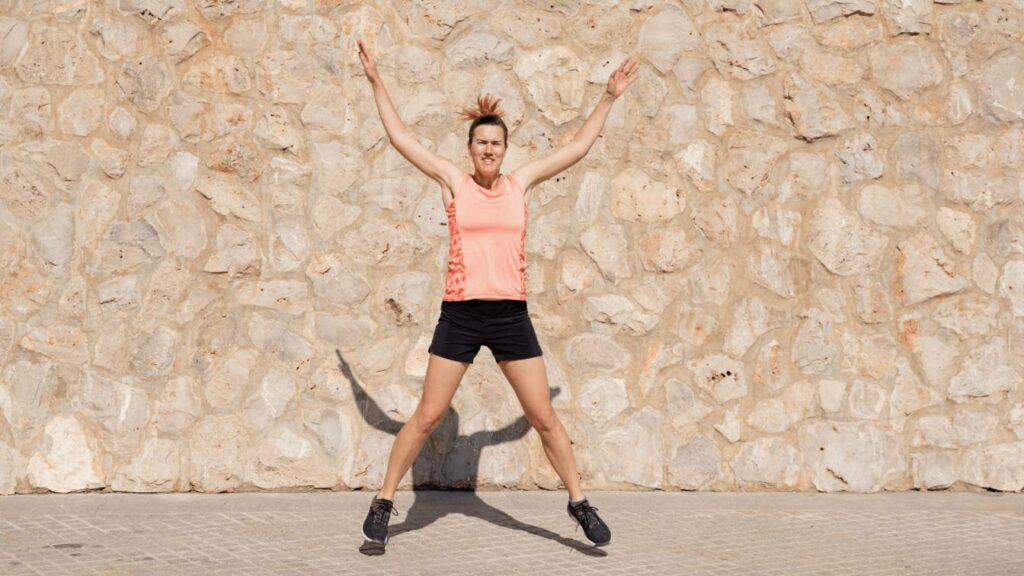Image Source: POPSUGAR
Are you looking for an intense and effective exercise to target your oblique muscles and enhance your core strength? Look no further than the breakdancer exercise. In this article, we will explore the breakdancer-exercise in detail, including its definition, step-by-step guide, modifications and progressions, benefits, sample workout routine, safety considerations, tips for incorporation, real-life success stories, and frequently asked questions (FAQs).
What readers will learn by reading the article:
- Definition and variations of the breakdancer exercise
- Step-by-step guide on how to perform the breakdancer-exercise from a tabletop position
- Modifications for beginners and ways to increase the difficulty of the exercise
- Benefits of incorporating the breakdancer-exercise into a fitness routine
- Sample breakdancer workout routine and safety considerations
- Tips for integrating the breakdancer-exercise into a fitness routine and tracking progress
- Real-life success stories and answers to frequently asked questions about the exercise
Understanding the Breakdancer Exercise
The breakdancer-exercise is a dynamic movement that combines elements of cardio, core training, and coordination. It is performed from a tabletop position, where you balance on your hands and toes with your body parallel to the ground. From this position, you rotate your hips and kick one leg through the other, mimicking the fluid movements of a breakdancer.
1. Definition and Overview
The breakdance-exercise is known for its ability to target the oblique muscles, which are located on the sides of your abdomen. These muscles play a crucial role in side-to-side bending, torso rotation, and spine stabilization. By incorporating the breakdancer-exercise into your fitness routine, you can effectively strengthen and tone your obliques, leading to a strong and functional core.
2. Effectiveness in Targeting Oblique Muscles
According to an article by Men’s Health on the 20 best oblique exercises, the breakdancer-exercise is listed as one of the top exercises for targeting the obliques. This exercise engages the oblique muscles through its rotational movement and challenges their strength and endurance. By performing the breakdancer-exercise regularly, you can develop defined oblique muscles and improve your overall core strength.
3. Variations of the Breakdancer Exercise
The breakdancer-exercise offers various variations to suit different fitness levels and goals. One common variation involves adding a push-up or a plank before transitioning into the breakdancer movement. This modification increases the intensity of the exercise by incorporating upper body and core strength. Additionally, you can experiment with different tempos, such as performing the breakdancer-exercise at a faster pace to elevate your heart rate and add a cardiovascular component to your workout.
Use of Merlin App for Break-dancer Exercise
The Merlin App is a valuable tool for individuals looking to perform exercises like the Break-dancer. This dynamic exercise, which combines elements of strength, balance, and agility, can be challenging to master without proper guidance. Here’s how the Merlin App can assist users in performing the Break-dancer exercise effectively.
First and foremost, the AI Real-Time Feedback feature is incredibly beneficial for those attempting the Breakdancer exercise. This exercise involves swift leg and torso movements while balancing on your hands, making it crucial to maintain the correct form to avoid injury. The app’s AI can monitor your movements and provide instant feedback on your form and technique. It can point out issues like misalignment, inadequate core engagement, or incorrect hand placement, helping users adjust their movements in real-time. This interactive feedback is akin to having a personal trainer by your side, ensuring that you perform the Breakdancer exercise safely and effectively.
The Customizable Workouts feature in the Merlin App is also a major asset when it comes to the Breakdancer-exercise. Users can tailor their workout plans to include this exercise, selecting the appropriate difficulty level and progression. For beginners, the app can introduce modified versions of the Breakdancer to build strength and coordination gradually. For advanced users, it can incorporate more challenging variations to keep the workout engaging and help them push their limits.
Step-by-Step Guide to Performing the Breakdancer Exercise
Now that we understand the significance and benefits of the breakdancer exercise, let’s explore how to perform it correctly to maximize its effectiveness and minimize the risk of injury. Follow the step-by-step guide below:
- Start in a tabletop position with your hands directly under your shoulders and your knees under your hips. Your body should form a straight line from head to toe.
- Engage your core muscles by drawing your belly button towards your spine. This will help stabilize your body throughout the exercise.
- Lift your knees slightly off the ground, balancing on your toes and hands.
- From this position, rotate your hips and kick one leg through the space between your other leg and arm. Aim to bring your knee towards your opposite elbow.
- Return to the starting position and repeat the movement on the other side, kicking the opposite leg through.
- Continue alternating sides for the desired number of repetitions or time.
Proper Form Tips and Cues
To ensure proper form and maximize the effectiveness of the breakdancer exercise, keep the following tips in mind:
- Maintain a strong and stable core throughout the movement.
- Focus on controlled and deliberate movements, avoiding any jerking or swinging motions.
- Keep your shoulders away from your ears and maintain a neutral spine.
- Engage your glutes and leg muscles to support your bodyweight.
- Breathe consistently throughout the exercise, exhaling as you kick your leg through and inhaling as you return to the starting position.
Common Mistakes to Avoid
While performing the breakdancer exercise, it’s important to be mindful of common mistakes that can hinder your progress or increase the risk of injury. Avoid the following errors:
- Arching or rounding your back: Maintain a neutral spine throughout the exercise to protect your lower back and engage the correct muscles.
- Lifting your hips too high or sinking them too low: Aim to keep your hips in line with your shoulders and knees to maintain proper alignment and stability.
- Rushing the movement: Focus on controlled and deliberate motions, rather than rushing through the exercise. This will ensure that you engage the targeted muscles effectively.
- Neglecting proper core engagement: Remember to activate your core muscles by drawing your belly button towards your spine. This will provide stability and maximize the benefits of the exercise.
- Not breathing properly: Breathing is essential during any exercise. Remember to breathe consistently and avoid holding your breath, as this can lead to unnecessary tension and compromise your form.
By paying attention to your form and avoiding these common mistakes, you’ll be able to perform the breakdancer exercise safely and effectively.
Modifications and Progressions
The breakdancer exercise can be modified to accommodate different fitness levels and abilities. Whether you’re a beginner or looking to challenge yourself, here are some modifications and progressions to consider:
Modifications for Beginners
If you’re new to the breakdancer exercise or have limited core strength, it’s important to start with modifications that allow you to develop proper form and gradually build strength. Here are a few modifications to try:
- Knee taps: Instead of kicking your leg through, focus on tapping your knee to the opposite elbow while maintaining a tabletop position. This reduces the range of motion and intensity, making it suitable for beginners.
- Slow tempo: Perform the breakdancer exercise at a slower tempo, allowing yourself to focus on stability and control. This modification helps develop core strength and coordination.
Progressions for Advanced Practitioners
Once you’ve mastered the basic form of the breakdancer exercise, you can progress to more advanced variations to continue challenging yourself. Consider these progressions:
- Weighted breakdancers: Hold a light dumbbell or kettlebell in one hand while performing the breakdancer exercise. This added resistance increases the difficulty and engages your muscles further.
- Elevated breakdancers: Elevate your feet on a stable platform, such as an aerobic step or a low bench. This modification increases the demand on your core muscles and provides a greater challenge to your stability and coordination.
Alternative Exercises
If the breakdancer exercise doesn’t suit your preferences or you’re looking for alternative exercises to target the oblique muscles, consider the following options:
- Side plank with hip dips: Start in a side plank position, balancing on one forearm and the side of your feet. Lower your hip towards the ground and then lift it back up, engaging your oblique muscles.
- Russian twists: Sit on the ground with your knees bent and your feet slightly off the floor. Hold a weight or medicine ball in front of your chest and rotate your torso from side to side, tapping the weight or ball on the ground on each side.
- Bicycle crunches: Lie on your back with your hands behind your head. Lift your shoulder blades off the ground and bring one knee towards your chest while extending the other leg. Alternate sides in a cycling motion, engaging your obliques with each twist.
Incorporating these alternative exercises into your routine can add variety and target your oblique muscles from different angles.
Benefits of the Breakdancer Exercise
The breakdancer exercise offers a range of benefits that extend beyond targeting the oblique muscles. By incorporating this exercise into your fitness routine, you can experience the following advantages:
- Oblique muscle targeting: As mentioned earlier, the breakdancer exercise specifically targets the oblique muscles, helping to strengthen and tone them. This can lead to improved definition, enhanced waistline, and better overall core strength.
- Core stability improvement: The breakdancer exercise requires a strong and stable core to perform the movement effectively. By regularly practicing this exercise, you’ll enhance your core stability, which is essential for maintaining proper posture, preventing injuries, and excelling in other physical activities.
- Athletic enhancement: The breakdancer exercise incorporates elements of coordination, balance, and agility, making it a functional exercise that translates to various sports and activities. By improving these skills, you’ll enhance your athletic performance and overall physical capabilities.
- Functional fitness: The breakdancer exercise mimics the movements of breakdancers, who are known for their agility and body control. By incorporating this exercise into your routine, you’ll develop functional fitness, which refers to the ability to perform daily activities with ease and efficiency.
Remember, these benefits can only be achieved with consistent practice and proper form. Make the breakdancer exercise a regular part of your fitness routine to reap its rewards.
To support the information presented, refer to the Shape article on 10 oblique exercises for a flat stomach. They highlight the effectiveness of exercises like breakdancers in targeting
| Exercise Name | Description | Difficulty Level |
|---|---|---|
| Breakdancer | Dynamic movement that targets oblique muscles and enhances core strength | Intermediate |
| Side Plank with Hip Dips | Variation of the side plank exercise that engages oblique muscles through controlled hip movements | Beginner |
| Russian Twists | Seated exercise that targets obliques by rotating the torso from side to side with a weight or medicine ball | Beginner |
| Bicycle Crunches | Supine exercise that engages oblique muscles by performing a cycling motion with the legs while twisting the torso | Beginner |
































